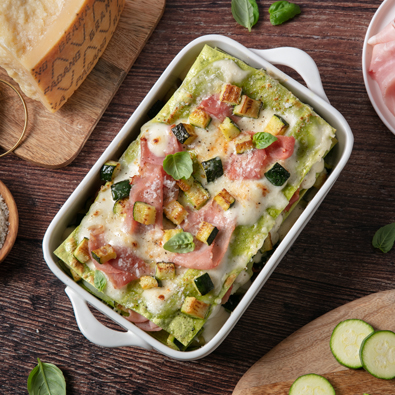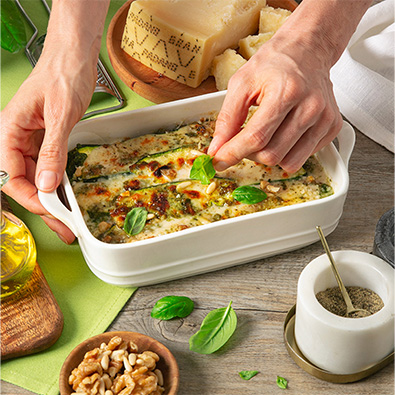
Pumpkin (pan-fried) lasagne with swiss chard, walnuts and Grana Padano
Chef Danilo Cortellini
I am a big fan of any pasta that is baked, for me it always bring back memories of Sunday family lunches when Nonna used to prepare her pasta al forno for us. With that in mind, it goes without saying that I am a big lasagne lover, my wife is in fact from Emilia Romagna so we often have lasagne when we visit the in-laws. Now let me ask you, what’s the best part of a lasagne? Opinions differs but if you ask me, the answer is the crusty parts on the top and corners, with still a bit of cheese and bechamel underneath…delicious!
You can’t blame me at this stage for wanting to try out the new social media trend of the moment, and that is pan-fried lasagne. It is very simple, take a large slice of cold lasagne and pan-fry it in olive oil and butter until you have a delicious golden crust on both sides. It sounds a bit silly at first but if you think about it, it is also a great way to re-heat leftovers and serve them in a different way (plus you get an incredible ratio of crust-pasta).
In this occasion, I opted for seasonal pumpkin lasagne with swiss chard, walnut pesto and of course my favourite Grana Padano cheese. Firmer in texture but still soft and delicious. I hope you guys are going to try it because it is so so so worth the work and it makes for a beautiful centrepiece for any special meal.
Ingredients
- 500 g of pumpkin (approx.)
- 2 garlic cloves
- 1 sprig of rosemary
- 3 tbsp of olive oil
- 500 g of swiss chard, blanched in salted water and cooled
- Butter to grease
- Chopped rosemary to sprinkle
- Grated Grana Padano to sprinkle
- For the Grana Padano béchamel
- 1 l of milk (warm, if possible)
- 70 g of butter
- 70 g of plain flour
- 300 g of grated Grana Padano
- A touch of nutmeg to taste
- Salt & pepper to taste
- For the pasta
- 350 g 00 flour (or all-purpose/plain flour)
- 150 g semola rimacinata aka durum wheat flour (or all-purpose/plain flour)
- 2 eggs (about 110 g)
- 180 g of egg yolk (around 5-6 egg yolks)
- Extra flour for dusting
- For the walnut pesto
- 250 gr of walnuts
- 50 gr of grated Grana Padano
- ½ garlic clove
- 20 ml of extra virgin olive oil
- A touch of water (or milk) to loosen it up
- Sat and pepper to taste












Chef’s tip
When the pasta is fresh and just made, I like to use raw pasta sheet directly as they are, in this way they will absorb more of the juices and flavours. Just make sure to keep the Grana Padano béchamel a little bit on the loose side by adding extra milk. If using store bought dry pasta sheets, boil them in salted water as usual before building the lasagne. Any pasta trimming can be re-used in soups or other dishes.